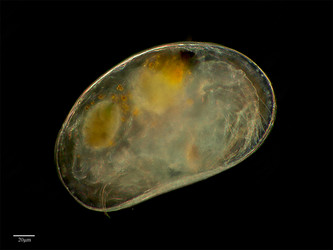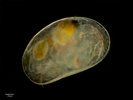Ostracoda
- Myodocopa
- Myodocopina
- Cypridinidae
- Cylindroleberididae
- Philomedidae
- Rutidermatidae
- Sarsiellidae
- Halocyprida
- Thaumatocyprididae
- Halocyprididae
- Polycopidae
- Myodocopina
- Podocopa
- Platycopida
- Punciidae
- Cytherellidae
- Podocopida
- Bairdiidae
- Bythocyprididae
- Bythocytheridae
- Cytheridae
- Cytherideidae
- Cytheromatidae
- Cytheruridae
- Entocytheridae
- Eucytheridae
- Hemicytheridae
- Kliellidae
- Krithidae
- Loxoconchidae
- Leptocytheridae
- Microcytheridae
- Neocytherideidae
- Paradoxostomatidae
- Pectocytheridae
- Protocytheridae
- Psammocytheridae
- Schizocytheridae
- Terrestricytheridae
- Thaerocytheridae
- Trachyleberididae
- Xestoleberididae
- Sigiliidae
- Pontocyprididae
- Macrocyprididae
- Candonidae
- Cyprididae
- Ilyocyprididae
- Notodromadidae
- Darwinulidae
- Platycopida
References
Abele, L. G., T. Spears, W. Kim, and M. Applegate. 1992. Phylogeny of selected maxillopodan and other crustacean taxa based on 18S ribosomal nucleotide sequences: a preliminary analysis. Acta Zoologica 73:373-382.
Cohen, A. C., J. W. Martin, and L. S. Kornicker. 1998. Homology of Holocene ostracode biramous appendages with those of other crustaceans: the protopod, epipod, exopod and endopod. Lethaia 31:251-265.
Martin, J. W. and G. E. Davis. 2001. An updated Classification of the Recent Crustacea. Natural History Museum of Los Angeles County Science Series 39. Los Angeles, CA.
Morin, J. and A. Cohen. 1991. Bioluminescent displays, courtship, and reproduction in ostracods. Pages 1–16 in: Crustacean Sexual Biology. T. Bauer and J. Martin, eds. Columbia University
Press, New York.
Parker, A. R. 1995. Discovery of functional iridescence and its coevolution with eyes in the phylogeny of Ostracoda (Crustacea). Proceedings of the Royal Society of London Series B 262:349-355.
Smith, R. J. 2000. The morphology of the upper lip of Cypridoidea ostracods: taxonomic and phylogenetic significance. Hydrobiologia 418:169-184.
Vannier, J. and K. Abe. 1995. Size, body plan and respiration in the ostracoda. Palaeontology 38:843-873.
Vannier, J. and K. Abe. 1992. Recent and early Paleozoic myodocope ostracodes - functional-morphology, phylogeny, distribution and life-styles. Palaeontology 35:485-517.
Information on the Internet
- IRGO, the International Research Group on Ostracoda.
- Ostracod Research Group. NRI - Department of Earth and Environmental Sciences, University of Greenwich, UK.
- Arctic ostracode database. U. S. Geological Survey.
- Ostracods of Southern Australia.
- The Non-marine Ostracods (Ostracoda) of Southern Africa. Compiled by Koen Martens.
- Ostracodologists at UFRGS - Brazil.
- The Micropalaeontological Society.
- Ian Boomer's home page. Research on the use of microfossils (Ostracoda and Foraminifera) to record past environmental change.
- Anchialine Caves and Cave Fauna of the World
Title Illustrations

| Scientific Name | Ostracoda |
|---|---|
| Location | Zamora, Castilla y León, Spain |
| Comments | Los ostrácodos son pequeños crustáceos que pueden llegar a medir desde unas decenas de micras hasta 3 mm de longitud y que habitan en cualquier medio acuático, desde las profundidades abisales de los océanos hasta las fuentes de aguas termales. Algunos son nadadores, otros viven sobre plantas acuáticas en el fondo de las aguas. Algunos son filtradores, otros son carroñeros, los hay detritívoros, herbívoros e incluso depredadores. También pueden ser parásitos o comensales de crustáceos, gusanos poliquetos, equinodermos e incluso tiburones. El rasgo más característico de los ostrácodos es su caparazón calcáreo compuesto por dos valvas y que puede envolver completamente el cuerpo y las extremidades. La determinación de los difrentes grupos de ostrácodos es complicada y se basa en las características y ornamentación de las valvas y la morfología de las extremidades. El caso es que nuestro ostrácodo soporta el invierno perfectamente, incluso el agua a punto de congelación. El individuo de la imagen ha sido fotografiado con 400 aumentos empleando la técnica de campo oscuro y procede de una muestra de agua recogida en una turbera de las inmediaciones de la Laguna de Peces en Sanabria (Zamora). También en www.iesbatalladeclavijo.com/tablon/webvidaoculta/index.html y en www.fotolog.com/proyectoagua. ...junto con nuestro granito de arena por la paz en http://www.fund-culturadepaz.org/spa/03/cent03Articulos%202003/En_pie_de_paz.pdf |
| Source | OSTRÁCODO |
| Source Collection | Flickr |
| Image Use |
 This media file is licensed under the Creative Commons Attribution-NonCommercial-NoDerivs License - Version 2.0. This media file is licensed under the Creative Commons Attribution-NonCommercial-NoDerivs License - Version 2.0.
|
| Copyright | © 2008 ANTONIO GUILLÉN |
About This Page
Page copyright © 2002
All Rights Reserved.
Citing this page:
Tree of Life Web Project. 2002. Ostracoda. Version 01 January 2002 (temporary). http://tolweb.org/Ostracoda/6247/2002.01.01 in The Tree of Life Web Project, http://tolweb.org/








 Go to quick links
Go to quick search
Go to navigation for this section of the ToL site
Go to detailed links for the ToL site
Go to quick links
Go to quick search
Go to navigation for this section of the ToL site
Go to detailed links for the ToL site